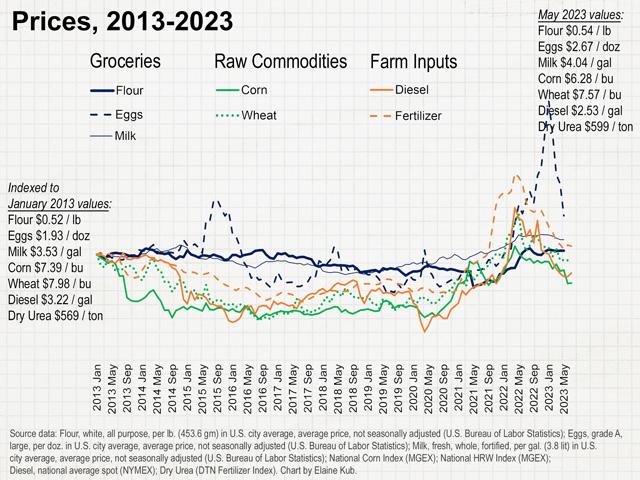Kub's Den
Don't Blame Grocery Sticker Shock on Underlying Grain Prices
When a grocery shopper buys a 5-pound bag of all-purpose flour, paying as little as $2.50, they're paying for much more than the value of the milled wheat inside the bag. A bushel of wheat being harvested in Kansas today is worth $7.80, but 5 pounds of hard red winter wheat is only 1/12th of a bushel. So, if the contents of the bag of grocery store flour were simply whole ground wheat, then 5 pounds of it would be worth only $0.65, and the rest of the price tag ($1.85) would be paying for the retailer's operations, the packaging, and all the various steps of transportation, handling, storage and milling that turned the wheat into flour and got the flour from the mill into the grocery shopper's hands.
It would only take a 72-square-foot patch of ground to grow 5 pounds' worth of wheat -- an area 8 feet wide by 9 feet long, for instance, if the yield is 50 bushels per acre (bpa). The harvesting crews sweeping across Kansas this July can harvest a 5-pound, $0.65 serving of wheat in less than half a second, travelling 4.5 miles per hour with a 30-foot combine header.
All that is to say, when Americans' monthly grocery bills are rising month by month -- and they have been, amid persistent inflation -- well, it's not necessarily the costs of the underlying food commodities that are driving those price tags. The spike in the price of eggs around the turn of the year, for instance, wasn't a response to higher feed costs in the corn and feed wheat markets. Although the grain markets did hit a peak the previous spring, that alone may not have shifted the price of eggs at all, if it hadn't been for the outbreak of Highly Pathogenic Avian Influenza that devastated the nation's flock of egg layers.
P[L1] D[0x0] M[300x250] OOP[F] ADUNIT[] T[]
Similarly, the peak in fertilizer and diesel prices last spring coincided with higher grain prices but did not cause them. Markets for annually produced commodities move based on supply and demand, independently from the underlying costs to produce those commodities, except at a very long scale. Consumer prices, therefore, as an amalgamation of all the goods and services that go into a final product, look relatively smooth and shielded from the boom-and-bust price streaks of individual underlying commodities.
I have a notebook from the Iowa Corn Promotion Board (iowacorn.org), which reassures consumers with the following factoids: "There's 7 cents worth of corn in a pork chop;" "There's 13 cents worth of corn in every gallon of milk;" "29 cents worth of corn is used in the creation of every one dozen eggs;" "That juicy 1/4-pound hamburger has close to 13 cents worth of corn in it;" "There's almost 7 cents worth of corn in a liter of soda;" and "6 cents worth of corn can be found in your morning cereal." However, these calculations were based on a corn price of $4 per bushel, and at certain points last year, the average cash price for corn in the United States was double that.
Monday, the DTN National Corn Index (an average of cash bids across the country) was $5.34. Therefore, the contribution of grain prices to overall grocery prices (e.g., eggs at $2.67 per dozen or milk at $4.04 per gallon) should in no way be feared as a primary driver of more inflation in months to come, nor should pressure from price-sensitive consumers be feared as an imminent bearish influence on grain prices.
**
Comments above are for educational purposes only and are not meant as specific trade recommendations. The buying and selling of grain or grain futures or options involve substantial risk and are not suitable for everyone.
Elaine Kub, CFA is the author of "Mastering the Grain Markets: How Profits Are Really Made" and can be reached at masteringthegrainmarkets@gmail.com or on Twitter @elainekub.
(c) Copyright 2023 DTN, LLC. All rights reserved.




